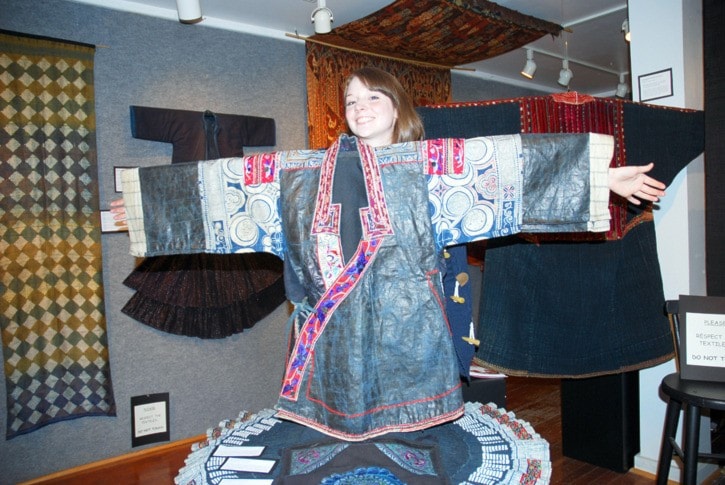Tree bark, silk, cotton — batik, natural indigo, shiney mirror, intricate patterns in elaborate embroidery — colour and more colour.
The Common Threads Exhibition at the Station House Gallery this summer is a spectacular display of passion for the textile arts that is found in the eastern cultures from India to Afghanistan, Laos, Papua New Guinea and beyond.
To explain and enhance enjoyment of this particular international exhibition the Station House Gallery is hosting a series of three brown bag lunch time videos that will expand on the notes that appear beside each of the pieces in the show.
The first of these videos by the Maiwa Foundation is called Through the Eye of the Needle: Stories From an Indian Desert. It takes place at the gallery today, Thursday, July 28 starting at noon.
This 30-minute documentary follows the journey of a unique group of crafts women as they return to creating the world-class embroidery that made their ancestors famous. The incredible stories of the women from the Kutch Mahila Vikas Sangathan co-operative are recorded through video, song, laughter, and stitch.
History here is worn as generations of knowledge are passed down through embroidered designs. Along a valuable item of trade, the embroideries also provide a common ground for women to meet and bring their stories to the world.
Through the documentary, viewers will experience the amazing landscape of the Kutch desert on India’s western border, the remarkable diversity of the communities who live there, and the breathtaking colours of their textiles.
Two more documentaries about the clothing and fabric hangings shown in the exhibition will follow in August.
The film Indigo: A world of Blue will be shown on Thursday, Aug. 4 at noon.
While many cultures now use synthetic indigom manufactured from coal tar or petroleum, the traditional indigo dye is produced from the indigofera plant, a legume that looks similar to alfalfa but is usually larger.
Indigo dye must be prepared from the fresh plant in an exacting and elaborate fermentation process that takes about a month.
Natural indigo contains several related dye chemicals that give different shades of blue including a violet tone called indigo red.
Natural indigo also produces a rich coppery sheen when pounded or ironed. Numerous examples of pounded indigo are included in the textile show, some dating back to the early 1900s.
The third documentary is called In Search of Lost Colour, the story of natural dyes, and takes place Thursday, Aug. 11 at noon.
Modern synthetic dyes can colour almost any material in a vast range of hues but only 150 years ago absolutely everything was dyed naturally.
In Search of Lost Colour looks at a range of dye techniques — from the caracol purpura snail in Mexico to the use of lac insects of Laos, to the jackfruit root to the most famous dye root of all: madder.
The resurgence of natural dyes and contemporary ideas of colour will be explored in a historical context and in relation to the rise of a global colour industry.
Guided tours of the exhibition are also available.
Donations are accepted at the door.
